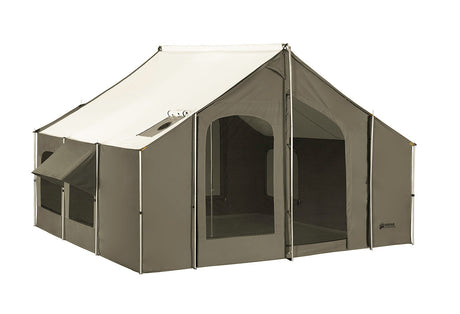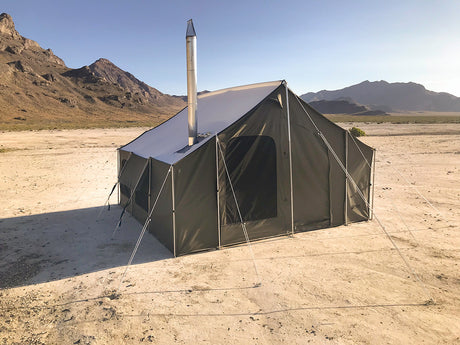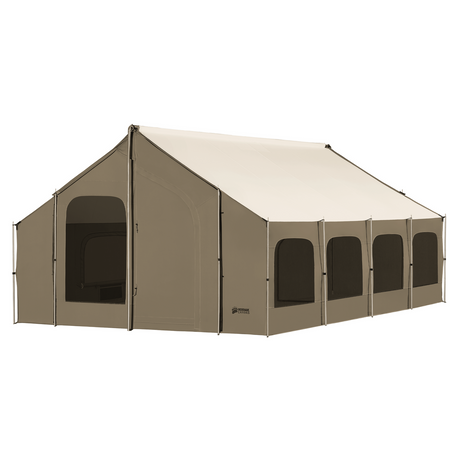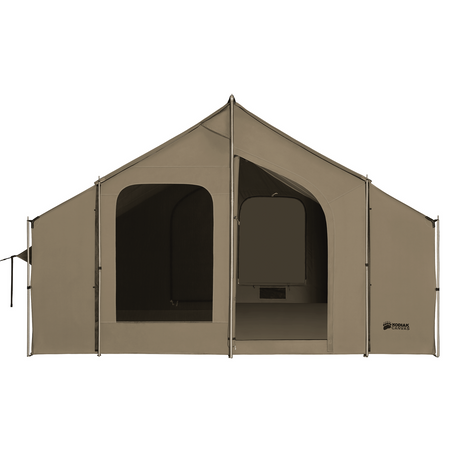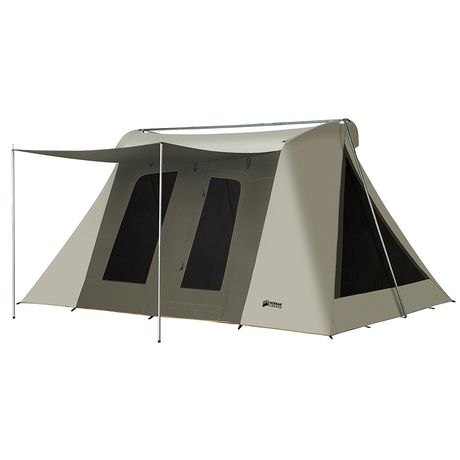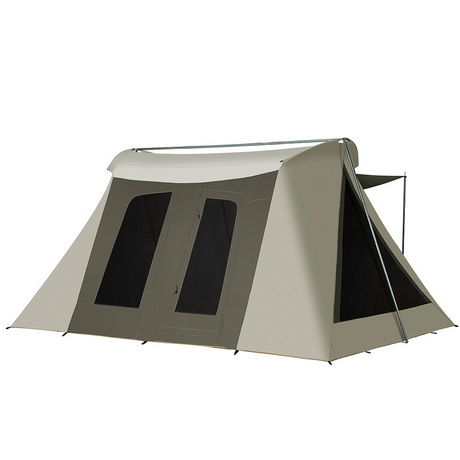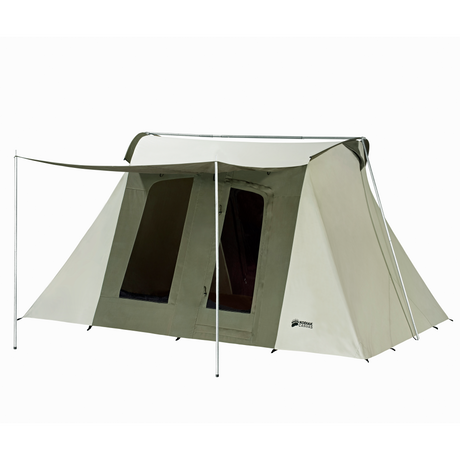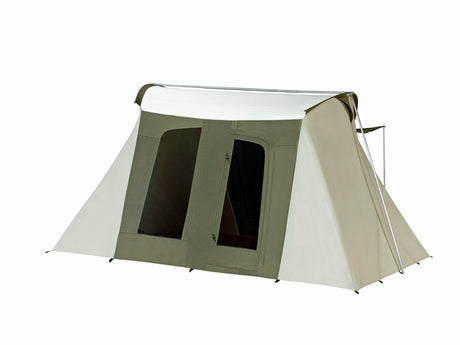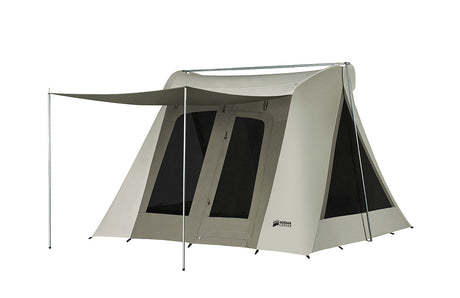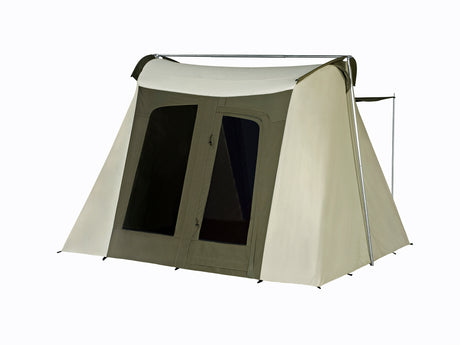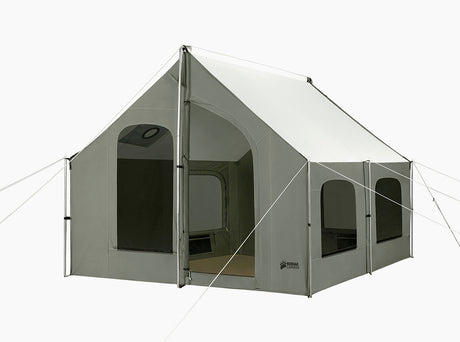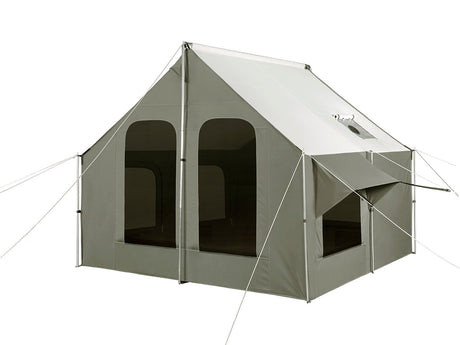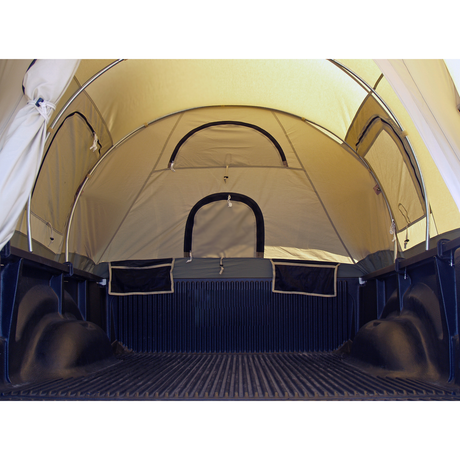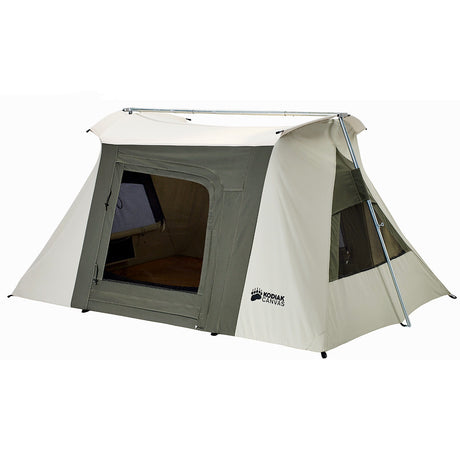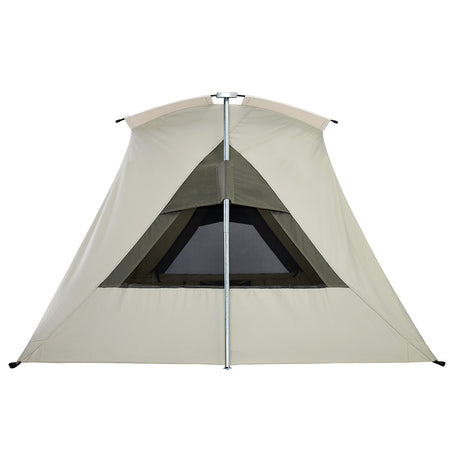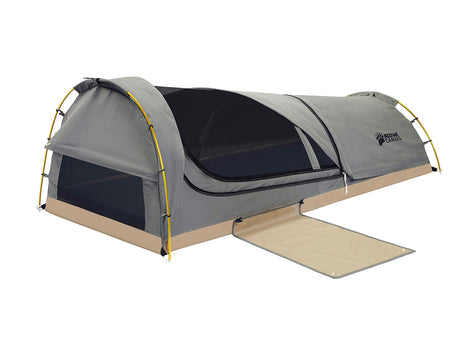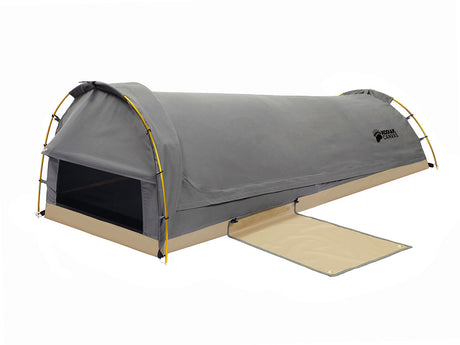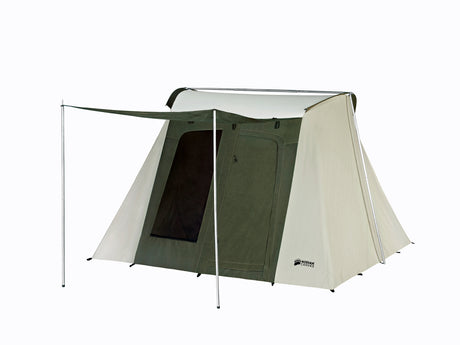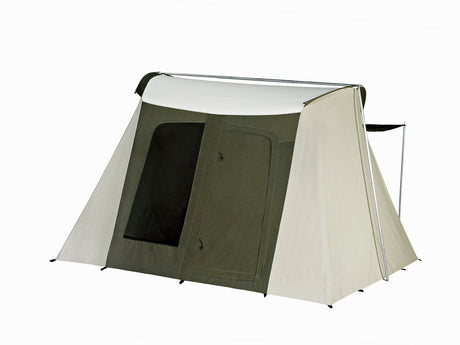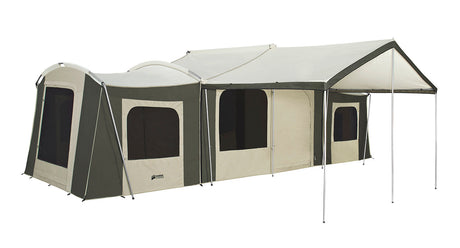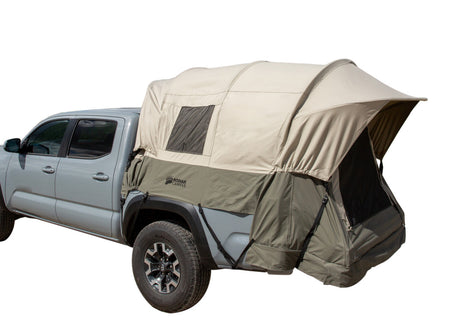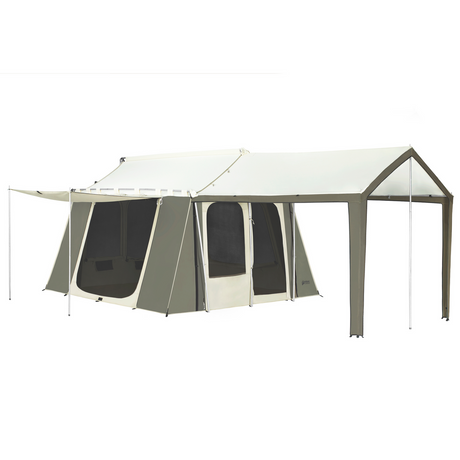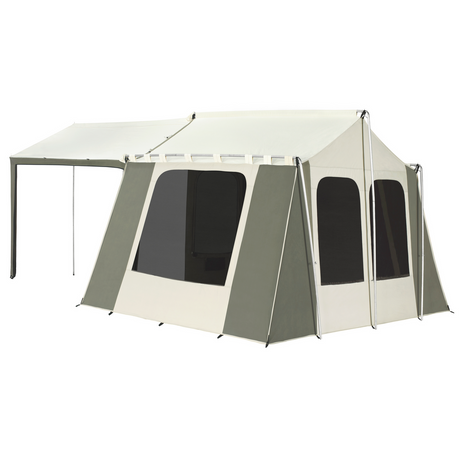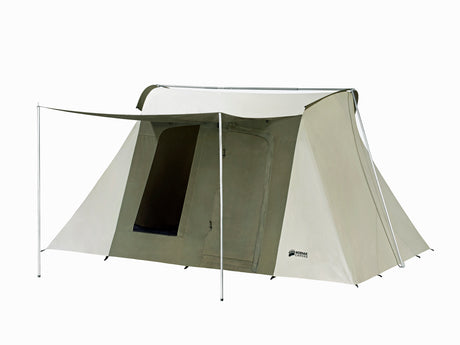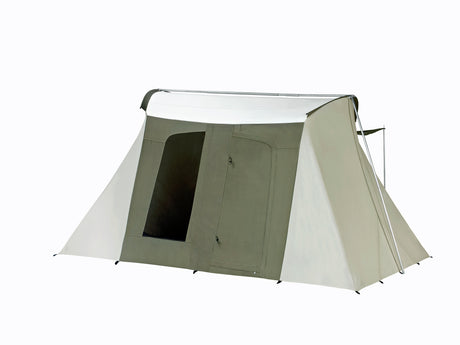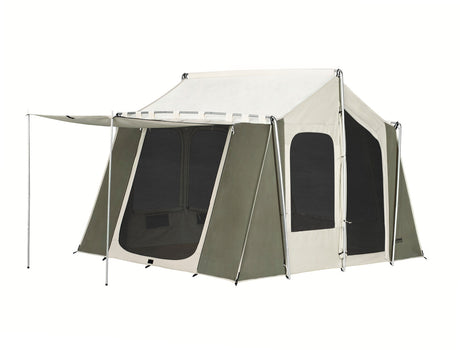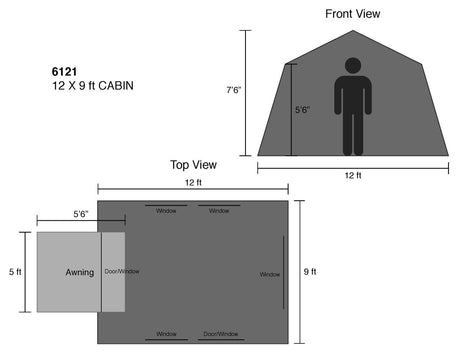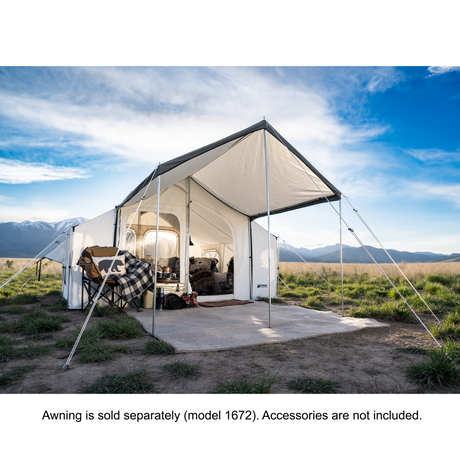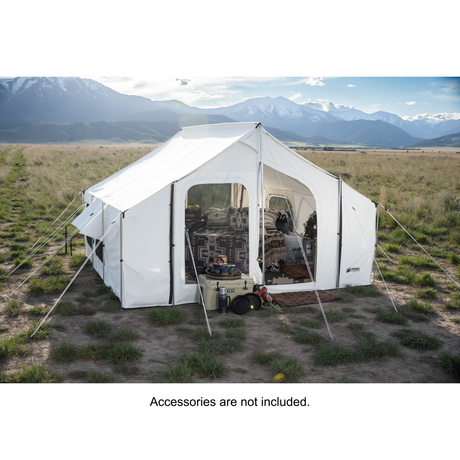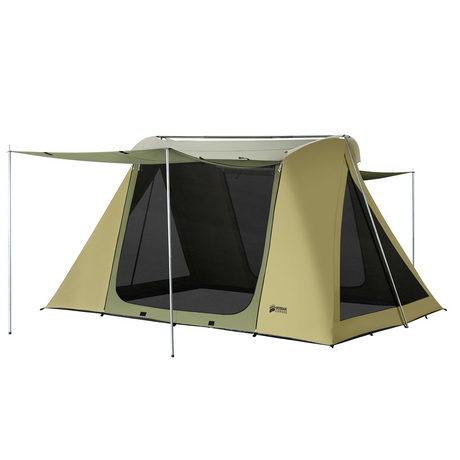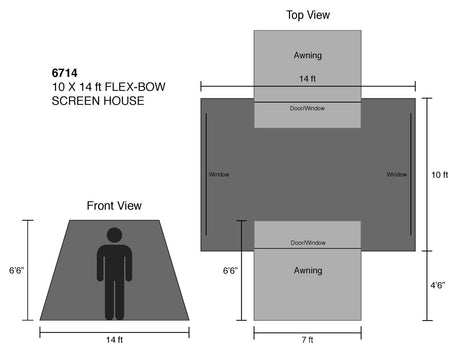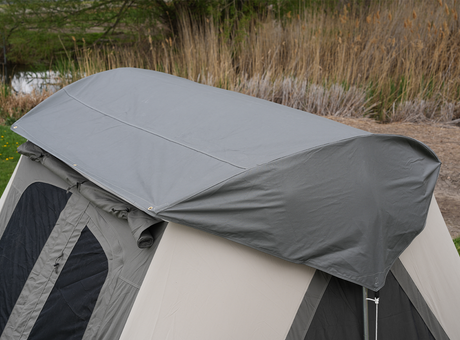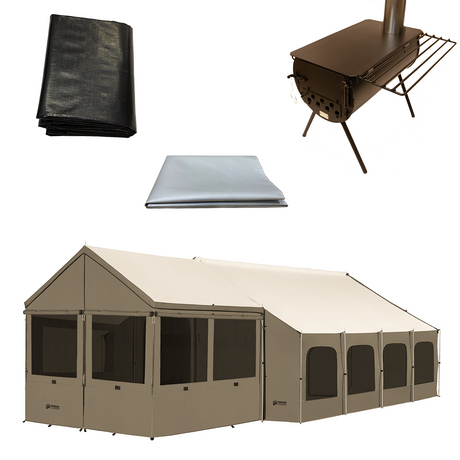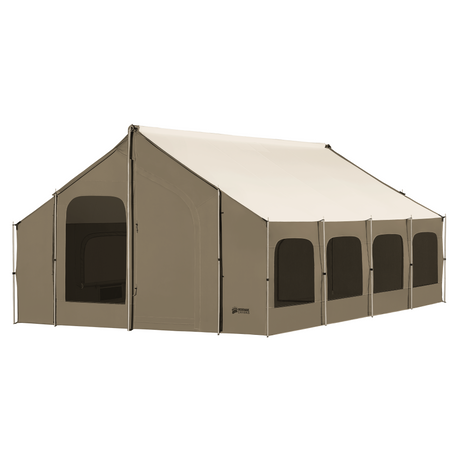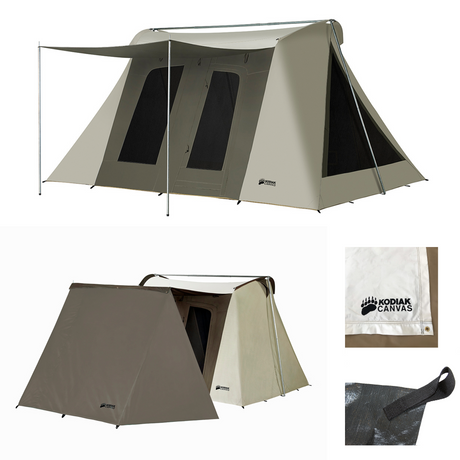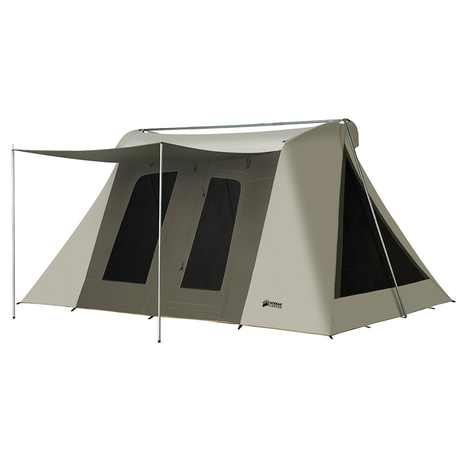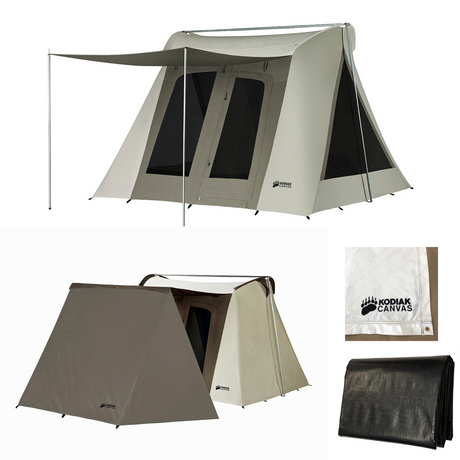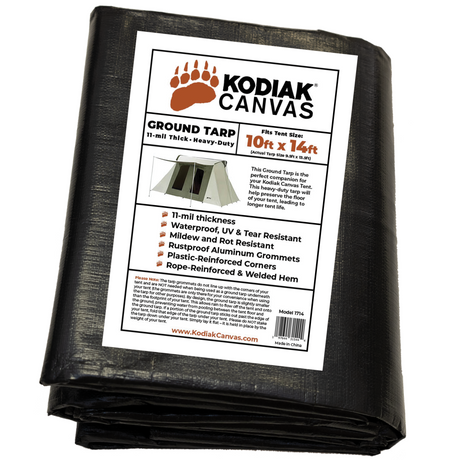Kodiak Canvas
26 x 8 ft. Grand Cabin Canvas Camping Tent with Awning
$999.99$1,799.99Unit price /UnavailableKodiak Canvas
12 x 9 ft. Canvas Cabin Camping Tent with Deluxe Awning
$879.99Unit price /Unavailable
Canvas or Synthetic/Nylon – what’s the best material for camping tents?
Tents are typically made from two different types of material: synthetic material (nylon) and cotton canvas. There are different grades and types of these materials, but they basically all boil down to those two materials. Kodiak Canvas camping tents are made with a superior, marine-grade, 100% cotton duck, Hydra-Shield® canvas. What is Hydra-Shield Canvas? It is a custom woven and treated canvas ideal for the purpose of premium tent making. It is double-fill cotton canvas (two threads twisted together to give the canvas superior strength, durability, and a very tight weave). The canvas is then treated with a silicone, dry-finish treatment that is watertight, breathable, and durable. Hydra-Shield canvas also resists mold and mildew.
So, what are the differences between Kodiak Canvas camping tents and camping tents made from synthetic or nylon material? Why should someone choose canvas over nylon, or vice versa? Each fabric has its benefit – for example, if you’re going on a back packing trip, nylon is a much lighter and packable material. However, if you are car camping, or setting up a base camp you can drive in to – a canvas camping tent is your best option. Here's why:
- Breathability. Unlike synthetic fabrics, or canvas with a paraffin or oil-based treatment, our Kodiak canvas is breathable! This allows water vapor to escape, minimizing condensation, humidity, and mugginess. Simply put, you are more comfortable. While no one likes the feeling of a humid or muggy tent, that same condensation can also lead to mold and mildew growing on your gear if you don’t air it out or dry it properly.
- Durability. Kodiak Canvas camping tents are made with a much ‘tougher’ material than your typical synthetic tent materials. There are many stories of canvas camping tents being passed down for generations. With the proper care, a quality canvas camping tent will serve you for many years to come. This same durability helps protect you in the outdoors as well. Whether it’s rain, snow, wind, or even critters, a durable canvas camping tent will outperform its synthetic or nylon tent siblings. Unlike canvas camping tents made with paraffin or oil-based treatments, you should rarely, if ever need to retreat the canvas. Kodiak’s Hydra-Shield silicone-based treatment is durable and long-lasting. Kodiak Canvas camping tents will outlast tents made with inferior synthetic fabrics.
- Water repellency. Speaking of weather and the elements, Kodiak Canvas camping tents shine when it gets nasty outside. Simply put, you will stay dry, even in a downpour! It's okay to touch ceiling and inside walls during a rainstorm. Hydra-Shield canvas does not leak or wick water. While we can’t call our canvas tents ‘waterproof’ (no cotton canvas is ‘technically’ waterproof), they are extremely water repellent, and our expectation is that you will ALWAYS stay high and dry in all weather you encounter. Read some of our customer love letters – our Kodiak Canvas camping tents have been through it all and continually protect our customers from the worst weather imaginable.
What are the different types of canvas camping tents?
The primary types of canvas camping tents are:
-
Flex Bow Tents (or spring rod style canvas tents)
- Canvas Flex Bow or spring rod style tents are hands-down the best tents for bad weather. The design and pole structure of this canvas tent helps it ‘flex’ without breaking in stiff winds. This canvas tent style has very simple construction with 1 main support pole (in multiple pieces) across the centerline of the canvas roof, with 2 spring rods on each of the canvas tent (4 total), then only 2 vertical support poles. This wonderful camping tent can be setup by a single person in in very little time. The cotton canvas material is excellent at repelling rain and water.
-
Canvas Cabin Tents
- This tent style has been a main stay for family camping over the past 100 years. If you ever camped as a kid with your family, you probably slept in a cabin-style tent. This design has been so popular over the years, that you can find it in various shapes, sizes and configurations – and different materials (canvas and nylon being the 2 primary ones). It is a sturdy tent, but given the surface area and pole structure, it’s not the best choice for high-wind areas. Setup is a little more complex as well with the number of poles used. It is typically best for 2 people to setup the canvas cabin tents. While canvas cabin tents are a little more complex, they do score high for usable space and durability.
-
Canvas Bell Tents
- Probably the oldest canvas tent design there is. Think of the Bedouins in ancient times packing their tent across the desert with their camels. Simplicity is the beauty of the bell tent style. You have a single center pole in a circle-shaped tent, and several guy lines around the canvas tent pulling it taught, and that’s it. What bell tents gain in simplicity, they lose in functionality. The ‘usable space’ in bell tents is reduced by the low walls, and a pole in the center that always seems to get in the way. From a headroom perspective, the only area you can stand in a bell tent is near the center area around the center pole. If you’re channeling Lawrence of Arabia, or looking for aesthetics over function (glampers take note), the canvas bell tent may be a fit for you.
-
Canvas Cabin Lodge Stove-Ready Tents or Hot tents
- While a lot of people use the term “hot tents” we prefer to call them “stove-ready” tents because there is nothing inherently ‘hot’ about any hot tent unless you’re camping in the middle of summer in Texas. Any stove-ready tent still needs a stove to make it hot. Wood burning tent stoves are hot. Canvas tents are not. Hence why we say ‘stove-ready tent’ and not ‘hot tent.’
- With that out of the way, there are pro’s and con’s to the Canvas Lodge Stove-Ready Tents. On the plus side, the usable space is fantastic. The ability to put a stove in your tent makes it a true 4-season tent. The heavy-duty vinyl floor and windows to ventilate are hands-down winners over the traditional wall tents. On the downside, these are heavier and bulkier tents and take up a decent amount of space in your vehicle or truck while transporting them (especially when you factor in your stove). They are a bit more complex to setup as well - it’s recommended you have 2 people available to set them up. You can’t beat the canvas stove-ready lodge tents when it comes to longer-term camping, or multi-day camping – but if you’re just going for an overnighter, you might look at other options.
-
Wall Tents
- Canvas wall tents are typically made of an aluminum or steel frame covered by cotton canvas roof and walls that attach to the frame of the wall tent. Typically, the roof and walls are separate pieces that you attach to the frame and to each other. A canvas wall tent does not have an integrated floor. Your floor is whatever ground you pitch your tent on (dirt, grass, snow, etc.). While the tent frame and material are strong and durable – especially for extended periods of time, there are some downsides. Wall tents won’t prevent a draft or wind from coming under the walls or water from running into your tent (where your tent wall meets the ground – it can get drafty and dusty in a windstorm, and depending on the slope you’re on, you may get water under the walls too in a rainstorm). They also don’t prevent critters from invading your space. While some wall tents have window options, most do not – which makes ventilation an issue. Wall tents are usually made with a paraffin or oil treated canvas which helps greatly with water repellency, but that same treatment doesn’t allow the canvas to breath as well. These tents are not for the faint of heart – wall tents are serious, heavy-duty tents meant for extended camping. Wall tents have wonderful usable space with tall walls and high ceilings. They are very strong and durable and will last many years if cared for properly. Setup and tear-down is more complex – more of a project – than what you’ll encounter with simpler canvas tents, and usually requires a minimum of 2 people to do it. These tents have their place and purpose, but wall tents aren’t your typical family camping tent.

